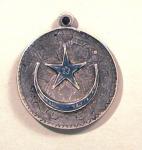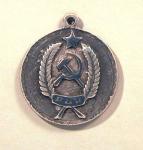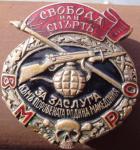-
Posts
1,147 -
Joined
-
Last visited
-
Days Won
12
Content Type
Profiles
Forums
Blogs
Gallery
Events
Store
Everything posted by Elmar Lang
-

Soviet An unknown Soviet-Asiatic Medal
Elmar Lang replied to Elmar Lang's topic in Russia: Soviet Orders, Medals & Decorations
-
Hello, during my cataloguing works, I've encountered a piece, about which I cannot find any info, although I think I've seen it already, somewhere... Material: silver, with nielloed black details (in the Caucasian style?); diameter 5,5 cm. Attached, the pictures of the obverse and reverse. If it's a very well known decoration, please don't laugh too loud at me... Thank you very much in advance, Enzo Obverse face:
-

Yugoslavia An unknown (to me) Decoration
Elmar Lang replied to Elmar Lang's topic in Southern European & Balkan States
Actually, I would like to know more about this aspect of Jugoslavian phaleristic: if the federative republics would have been allowed to award their own decorations; in other words, if there existed "Federal" and "Federative" awards. Where the work of cataloguing for auction ends, my cultural research and study continues... Best wishes, Enzo -

Yugoslavia An unknown (to me) Decoration
Elmar Lang replied to Elmar Lang's topic in Southern European & Balkan States
I think that our colleagues are talking about the former Socialist Federative Republic of Makedonia, once part of Tito's Jugoslavia. Best wishes, Enzo -

Yugoslavia An unknown (to me) Decoration
Elmar Lang replied to Elmar Lang's topic in Southern European & Balkan States
Oh, I see I've wrongly transliterated the motto: I've written "IDIN DEN 1903", but it should have been correctly written "ILIN DEN 1903". The piece I've observed, bears the number "102"; there are no silver or manufacteurer's marks, besides the "IKOM ZAGREB on the screw's nut. Thank you again for the further, important information, Best wishes, Enzo -

Yugoslavia An unknown (to me) Decoration
Elmar Lang replied to Elmar Lang's topic in Southern European & Balkan States
Thank you very much! Enzo (Elmar Lang) -

Yugoslavia An unknown (to me) Decoration
Elmar Lang posted a topic in Southern European & Balkan States
Hello, in these days I'm describing a collection of Orders & Decorations from the former Socialist Countries: of course, Yugoslavia is very well represented. Among the various pieces, there is one I've already seen, but I cannot remember what would it be: it's a silver-gilt 4-pointed star (6,2 x 6,2 cm.) with a superimposed centre medallion in silver, representing a partizan (?) within a laurel wreath, armed with dagger and bandoleers, holding a flag on a background of attacking men and women; below, a scroll with the (cyrillic) inscription "IDIN DEN 1903" the reverse is plain, struck with a serial (or award) number "102", scew and nut (this, marked "IKOM ZAGREB"). Any help would be most appreciated. Thank you in advance, Elmar Lang -

Bulgaria Marshal of Bulgaria's Star neck badge
Elmar Lang replied to Elmar Lang's topic in Central & Eastern European States
Thank you very much for the information. Is this badge properly a "Marshal's Star"? When was it instituted? And, last but not least (although this could sound a stupid question), who's the bulgarian General in the picture? Best wishes, Enzo -

Austria-Hungary Need opinions on "SIGNUM LAUDIS" medal
Elmar Lang replied to Luka's topic in Austro-Hungarian Empire
A piece in almost pristine condition. A collector couldn't find a better Bronze Signum Laudis, with case from WW1. Best wishes, Enzo -

Austria-Hungary Austria Merit Order Class ?
Elmar Lang replied to christerd's topic in Austro-Hungarian Empire
Hello, your order has a very nice case, and it's printed with a very early mark of the Souval manufacture. Best wishes, Enzo -
Thank you Jens, I've had a chance to see a group of orders and decorations belonged to members of the Anrep and Anrep-Elmpt family (they had high ranking officers serving in the Russian army in the late 18th Century and during the napoleonic wars; other members (but I'm not sure if descendants of female members, so with other surname), served in Germany and Imperial Austria. Among other pieces there is a EK2-1870, so I've asked for info and try to attribute that Iron Cross. Best wishes, Enzo
-
Hello, Your sword is what remains of a State Official's side-arm. The "Viribus Unitis" words are not referring to the famous Austrian warship but they are the motto (Wahlspruch) of emperor Franz Joseph I. Best wishes, Enzo
-

Austria-Hungary Austria Merit Order Class ?
Elmar Lang replied to christerd's topic in Austro-Hungarian Empire
Hi Christer, your piece is original and having it in the original case (also with manufacturer's mark of Souval?) is a plus. The Merit Order awarded from the government of the Austrian 1st Republic was made by Rothe; Reitterer and Souval. During WW1, Souval was also the maker of the (original) Milit?rverdienstkreuz 1st Class. Best wishes, Enzo -
Hello, a friend of mine has this badge, but I cannot understand when was it distributed. The motto on the Red Banner means "Liberty or Death" and the text below means something related to merits etc. towards the Makedonian Motherland. The other words, "...КЪМЪ ПОРОБЕНАТА..." sound not Russian to me (Bulgarian? Serbian?); the abbreviation "ВМРО" sounds also unknown to me. The fastening is the typical screwback with circular nut. Any idea about date and a possible identification?
-
Hello, in my opinion, it's a late, wartime piece. I've seen that Kriegsdekoration with identical obverse and reverse already. It would also be necessary to identify the marks. Best wishes, Enzo
-
Hello, back to the Albanian Orders awarded under the Italian rule, I need to remember that their position in the Royal Italian system of honour is completely different from that of France and its "Ordres Coloniaux". Albania was not a colony, but a kingdom with the same ruler as Italy. Victor Emanuel III's title began like this: "...Kingdom of Italy and Albania; Emperor of Ethiopia; (...)". Our colonial possessions (besides small "bureaus" and islands from Greece to China) actually were Somalia and Erithrea only, since Lybia, after WW1 had the status of a region of Italy, with a governor, because of the Mediterranean dividing it from the Continent and Ethiopia, remained with its status of Empire, but under Italian rule. The only state, maintaining a proper system of honour was Albania and, all Albanian Orders were awarded from Victor Emanuel as "King of Albania", in no way as Italian "colonial" awards. Maybe, papers and statistics could still be preserved somewhere at our State Archive in Rome. It's an enormous site and part of it is organized as huge vaults: surprises can happen, because more or less 8 years ago in one of the safes, a group of orders belonged to Mussolini was found. This group was considered as lost since 1943. Among them, the German Eagle with brilliants and a Grand Cross of the Besa, also with brilliants. Best wishes, Elmar Lang
-
Hello Holger, Italy occupied Albania in 1939 and Victor Emanuel III took also the title of "King of Albania", besides "King of Italy and Emperor of Ethiopia". From that date, the already existing orders of Skanderbeg and Besa, were slightly modified from the model awarded in King Zog's time, adding the Savoy's motto "FERT"", the Fasces, etc. The orders, from then on, were awarded as national Albanian awards, of course, from the ruler, who was in the same time King of Italy and of Albania. The two orders, in the Italian, form were awarded until 1943 but until now I don't know how many pieces have been awarded in the various classes. I know that a deep study on the subject is now in progress in Albania: let's hope that it would became a book soon. Best wishes, Elmar Lang
-

Albania Albanian military uniforms
Elmar Lang replied to stephenmiller's topic in Southern European & Balkan States
Hello, I regret to inform that my father's book from the Intelligence Service doesn't illustrate the uniforms and insignia of Albania. It includes those of all other Socialist powers of the Warsaw Pact and Yugoslavia. Best wishes, Enzo -
An interesting observation indeed. There are two possibilities, and in both cases the tailor wasn't paying attention to regulations... 1) a Generalmajor with too a short red cloth collar patch (correct Generalsborte, wrong collar patch); 2) a Major where the Generalsborte was used (wrong Borte, correct collar patch). Is there any label sewn inside the inner pocket? From that, one could have an idea about the original owner's rank... Best wishes, Enzo
-
... but paying attention to the "Borte", the last one looks to me a Generalmajor's field tunic... E.L.
-
I think he means the three or two lines in the zick-zack. E.L.
-

Albania Albanian military uniforms
Elmar Lang replied to stephenmiller's topic in Southern European & Balkan States
Hello, I remember that during the Cold War, the Italian Military Intelligence Service, printed a fine book, fully illustrated with colour plates, depicting the uniforms of the Warsaw Pact and other Socialist/Communist Armed Forces. As soon as I'll visit my parents, since the book belongs to my dad (a retired Army Officer), I'll see if Albania would have also been illustrated, hopefully with the old-fashioned uniforms. Best wishes, Enzo





